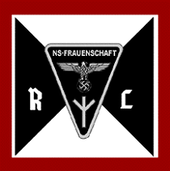Nazi women

The NS-Frauenschaft ( NSF for short ) was the women's organization of the National Socialist German Workers' Party (NSDAP). It came into being in October 1931 as an amalgamation of several nationalist and Nazi women's associations, such as the German Women's Order (DFO) , which was established in Berlin in 1926 . From then on, women were subordinate to the NSDAP Reich leadership. Girls and young women fell under the jurisdiction of the Association of German Girls (BDM).
tasks
In connection with this reorganization, the head of the Reich Organization of the NSDAP , Gregor Strasser , limited the tasks of the women's organization to economic and nursing activities as well as participation in the political training of female NSDAP members.
After the Nazi seizure of power from 1933, the NSF served the DC circuit of all other non-Nazi women's groups and associations under the umbrella Association of German Women's work (DFW). The political influence of the NSF within the NSDAP and on the rulers of the state, however, tended towards zero. This may have been due to the National Socialist image of women , which did not provide for political or even power participation for women. The "German woman" was defined as a housewife and mother , a distribution of roles that was also propagated by the Nazi women. Care in general and the upbringing of children were dubbed “female living space” (in the sense of social environment), a designation that National Socialism adopted from the conservative, middle-class women's movement .
The women's training courses for mothers, which by 1937 had already been attended by every fifth woman (over 20 years of age), had a broad impact. The training content was based primarily on the book The German Mother and Her First Child by the National Socialist Johanna Haarer .
Obviously based on the model of the National Women's Service in World War I , at least in Tübingen , public relations work, especially on consumer issues, was often carried out - housekeeping should also be carried out in accordance with the system and contribute to the self-sufficiency of the Reich. Example: Today we cook with cabbage , with recipes.
With the mandate to carry out systematic supervision, training and management tasks, the members had to take part in the weekly women's evenings at least once a month. The focus of this educational work was on preparing women for their tasks as housewives and mothers. This took place within the framework of courses on household and health management as well as on educational issues. The NSF had its own imperial and regional schools for these training tasks.
structure
The internal structure of the Nazi women's group corresponded to the structure of the NSDAP with subdivision into Gau, Kreis, local group, cell and block or “household group”. Each of the 40 districts was headed by a Gaufrauschaftsleiterin, in the next organizational unit there were about 800 district women leaders, to which 28,000 local women leaders were subordinate. According to its own information, on December 31, 1932, the National Socialist Women's Association had 109,320 members; in the meantime, as in the NSDAP, there was a membership ban , in 1939 there were 2.2 million members.
In 1933, after Elsbeth Zander (1888–1963), the founder and first chairwoman of the German Order of Women (also known as the "Red Swastika") , Lydia Gottschewski was dismissed from the leadership of the National Socialist Women's Union in April 1933 by Reich Organization Leader Robert Ley , the Reichsleiterin of the Federation of German Girls (BDM), head of the Nazi women's group. From February 24, 1934 until the end of the Second World War in 1945, the Nazi women's group was headed by the "Reichsfrauenführer" Gertrud Scholtz-Klink , who also headed the DFW.
Prohibition
With the Control Council Act No. 2 of October 10, 1945, Nazi women were banned by the Allied Control Council and their property was confiscated. The district women leaders fell under automatic arrest as the "main culprits" and were interned for denazification .
See also
literature
- Christiane Berger: The "Reichsfrauenführer" Gertrud Scholtz-Klink. On the impact of a National Socialist career in the course, retrospective and present. Dissertation, University of Hamburg, Department of Economics. Hamburg 2005 ( online August 7, 2007).
- Massimiliano Livi: Gertrud Scholtz-Klink. The Reichsfrauenführer. Lit-Verlag, Münster 2005, ISBN 3-8258-8376-0 .
- Kathrin Meyer: Denazification of women: the internment camps of the US zone of Germany 1945–1952 . Metropol, Berlin 2004.
- Leonie Wagner: "Guardians of the Race" - women's organizations of the NSDAP . In: Stephanie Becker and Christoph Studt (eds.): “And they will no longer be free their whole life.” Function and status of the NSDAP, its branches and affiliated associations in the “Third Reich”. (Series of publications by the Research Association July 20, 1944 eV 16). LIT, Berlin 2012, pp. 248-267, ISBN 978-3-643-11892-9 .
- Leonie Wagner: National Socialist women's views. Concepts of femininity and politics of leading women in National Socialism . 2nd, revised edition. Mensch & Buch Verlag, Berlin 2010, ISBN 978-3-86664-765-7 .
Web links
Individual evidence
- ^ Daily newspaper Tübinger Chronik , April 1, 1937
- ^ Website of the German Historical Museum
- ^ Wolfgang Mück: Nazi stronghold in Middle Franconia: The völkisch awakening in Neustadt an der Aisch 1922–1933. Verlag Philipp Schmidt, 2016 (= Streiflichter from home history. Special volume 4); ISBN 978-3-87707-990-4 , pp. 69 and 269.
